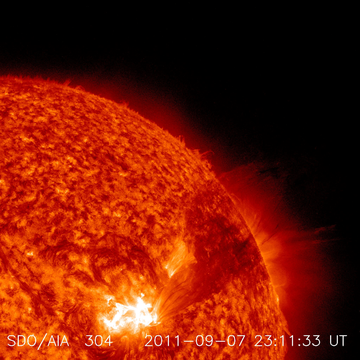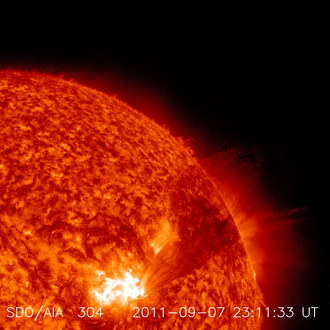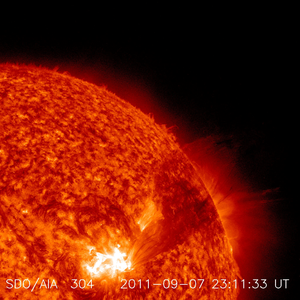Closer to the Sun than ever
Scientists in Potsdam are preparing for the start of ESA’s “Solar Orbiter” mission.
On 4 October 2011 the European Space Agency (ESA) has selected the Solar Orbiter mission for implementation. This spacecraft will investigate how the Sun influences its environment with the launch date planned for 2017. The Leibniz Institute for Astrophysics Potsdam (AIP) contributes with instrumentation for this mission.
AIP scientists and engineers are designing the imager, a 55 cm long telescope tube, for the remote sensing X-ray telescope STIX (“Spectrometer/Telescope for Imaging X-rays”). STIX is built by a collaboration of institutes from France, Poland, Czech Republic, Ireland, Austria, and Italy, led by Switzerland. The AIP is the only German institute in the STIX team.
Solar Orbiter will approach and revolve around the Sun at a distance of only a quarter of our Earth’s orbit. It will commence data acquisition after a three years cruise phase. This mission will enable the scientists for the first time to co-rotate with the Sun and observe the same spot for an extended period of time. These observations will lead to a deeper understanding of the evolution of sunspots, solar flares and the solar magnetic field.
The solar physicists at AIP are interested particularly in energetic particles that are released during solar flares. Therefore, in collaboration with the Christian-Albrechts-Universität in Kiel, AIP builds electronic components for the particle detector suite EPD (Energetic Particle Detector). The solar wind, solar flares and coronal mass ejections are parts of space weather, which has an important impact on Earth, our climate, and our technologically advanced civilization.
Equipped with numerous instruments, from a very close and unique perspective, Solar Orbiter will try to answer many of the still open questions of solar physics. Indeed, Solar Orbiter is expected to open a new chapter in solar science.
Further information
ESA press release about the selection of the missions „Solar Orbiter“ and „Euclid“
Scientists in Potsdam are preparing for the start of ESA’s “Solar Orbiter” mission.
On 4 October 2011 the European Space Agency (ESA) has selected the Solar Orbiter mission for implementation. This spacecraft will investigate how the Sun influences its environment with the launch date planned for 2017. The Leibniz Institute for Astrophysics Potsdam (AIP) contributes with instrumentation for this mission.
AIP scientists and engineers are designing the imager, a 55 cm long telescope tube, for the remote sensing X-ray telescope STIX (“Spectrometer/Telescope for Imaging X-rays”). STIX is built by a collaboration of institutes from France, Poland, Czech Republic, Ireland, Austria, and Italy, led by Switzerland. The AIP is the only German institute in the STIX team.
Solar Orbiter will approach and revolve around the Sun at a distance of only a quarter of our Earth’s orbit. It will commence data acquisition after a three years cruise phase. This mission will enable the scientists for the first time to co-rotate with the Sun and observe the same spot for an extended period of time. These observations will lead to a deeper understanding of the evolution of sunspots, solar flares and the solar magnetic field.
The solar physicists at AIP are interested particularly in energetic particles that are released during solar flares. Therefore, in collaboration with the Christian-Albrechts-Universität in Kiel, AIP builds electronic components for the particle detector suite EPD (Energetic Particle Detector). The solar wind, solar flares and coronal mass ejections are parts of space weather, which has an important impact on Earth, our climate, and our technologically advanced civilization.
Equipped with numerous instruments, from a very close and unique perspective, Solar Orbiter will try to answer many of the still open questions of solar physics. Indeed, Solar Orbiter is expected to open a new chapter in solar science.
Further information
ESA press release about the selection of the missions „Solar Orbiter“ and „Euclid“
Images
Solar flare.
Big screen size [1000 x 1000, 1.2 MB]
Original size [2100 x 2100, 1.8 MB]





